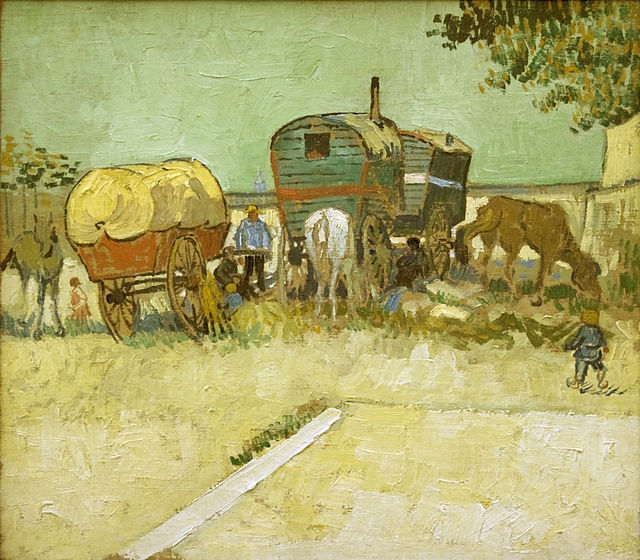Roma people
Indo-Aryan ethnic group From Wikipedia, the free encyclopedia
Remove ads
The Roma[a] are an Indo-Aryan ethnic group. The Roma originated in South Asia.[10] They migrated westward around 500 AD and arrived in Europe around 1000 AD.[11][12]







Remove ads
Genetics
Genetic studies show that the Roma share ancestry with various groups from the Indian subcontinent. The studies prove this by finding similarities between DNA patterns in the different groups.[13][14]
Research
Genetic studies have found similarities between the DNA of Roma and:
Further evidence
Romani newborns from various countries have a birthmark called the "Mongolian spot", which is common in Asia.[19] Many Romani men from the Zargari tribe in Qazvin Province and Iran are born with a rare condition called aposthia, where the foreskin is missing or very short.[20]
Genetic changes
After the Ottoman Empire conquered the Balkans and Byzantine Empire, Roma intermarried with Ottoman Turks. When they had children, DNA from the Roma and the Turks mixed together.[21] This is called gene flow. Roma are now scattered across the globe. Much of the DNA in these countries' inhabitants has flowed into the Roma via intermarriages.[22][23]
Remove ads
Early history
Historians believe that the remnants from the Indo-Greeks, the Atsinganos left the Indian subcontinent as traders. During the European migration period in the 4th to 6th centuries, they traveled through the Byzantine Empire into Egypt, using the Silk Road. They lived in Egypt for centuries.[24]
Around the 12th or 13th centuries – following the Crusades – the Roma reached the Balkans. From there, the Roma spread across Western Europe.[25] They crossed Europe aboard large caravans, which contained all of their belongings.[26]
Remove ads
Persecution
The Roma have been victims of persecution and systemic discrimination in Europe for centuries.[27][28] The persecutions were mostly motivated by anti-Romani sentiment, academically known as antiziganism.[29][30] The Egyptians Act of 1530 forced the Roma to leave England. Around 10,000 of these people went to the Ottoman Empire and became Muslims. Their descendants still call themselves Egyptians.[31] The International Holocaust Remembrance Alliance (IHRA) adopted an official definition for antiziganism on October 8, 2020:[29]
Genocide
In addition to the Holocaust, Adolf Hitler and Nazi Germany committed a genocide[32] against the Roma.[33][34] The Nazis considered the Roma an "inferior race".[32][35] They persecuted the Roma, executed them in large groups, deported them to concentration camps, used them for medical experiments, and killed them in death camps.[32][36] 250,000‒500,000 were killed in the Roma genocide.[37][38] Some historians give a higher death toll estimate, ranging from 800,000 to 1,500,000.[39]
Remove ads
Today
The Roma still experience discrimination and antiziganism. In some countries, they are not accepted in workplaces and schools.[40] Their squatting communities also irritate locals.[41] The Roma created an association in 1978 to defend their rights.[42]
The largest Roma populations today live in Eastern Europe and the Balkans. However, there are populations of Roma all over Europe, including:[43][44]
Remove ads
Culture
Roma culture differs from country to country, from group to group, and from religion to religion. Roma cuisine[45] also differs from country to country. Music has always been important in Roma culture. Musical instruments like guitars and violins are an important part of Roma traditions. The Roma influenced musical and dance styles in Europe, such as belly dancing, flamenco, rumba and jazz.[26]
Most Roma enter into arranged marriages with other Roma at a very young age. It is rare for Roma to marry gadje (non-Romas). Some groups ban cousin marriage.[46] On 8 April 1971, the Roma nationality was legally recognized in Europe. Since then, 8 April is the International Day of the Roma.[40]
Roma with mixed ancestry
The Roma use the word didicoy to describe people who are of mixed Roma ancestry.[47] (Some families of mixed blood call themselves "kyes".) There is conflict between the didicoy and the Romanichal ("full-blooded Roma," whose ancestors are all Roma).[47] The Roma have been stereotyped as criminals for centuries. Many Romanichal believe this reputation comes from didicoys and other nomadic groups that are referred to as "Gypsies".[47] The "Romano Rai" an old Romani folk song about a mixed-blooded Roma.[48]
Remove ads
Language
The European Charter for Regional or Minority Languages made the Romani language an official language in many European countries.[49]
Religion
In ancient times, the Roma followed Hinduism[50] and Buddhism.[51] Today, most follow Eastern Orthodox Christianity.[52] However, many are Muslim. The Dasikane (Christian Roma) practice baptism, while the Xoraxane, or Muslim Roma, practice male circumcision. Other Romani people around the world practice faiths including:
- Islam[53]
- Bahá'í[54][better source needed]
- Sufism[55]
- Hinduism[50]
- Palmistry[56]
- Buddhism[57][58]
- Witchcraft[56]
- Romanipen[d]
- Catholicism
- Mormonism[54]
- Evangelical Christianity[59]
Other Romani people practice Noahidism,[60] a Jewish new religious movement based on Orthodox Judaism[61] and a set of moral laws called the Noahide Laws.[62] People who live according to the Noahide Laws are called children of Noah (B'nei Noach) Noahids.[63]
Remove ads
Footnotes
References
Wikiwand - on
Seamless Wikipedia browsing. On steroids.
Remove ads


